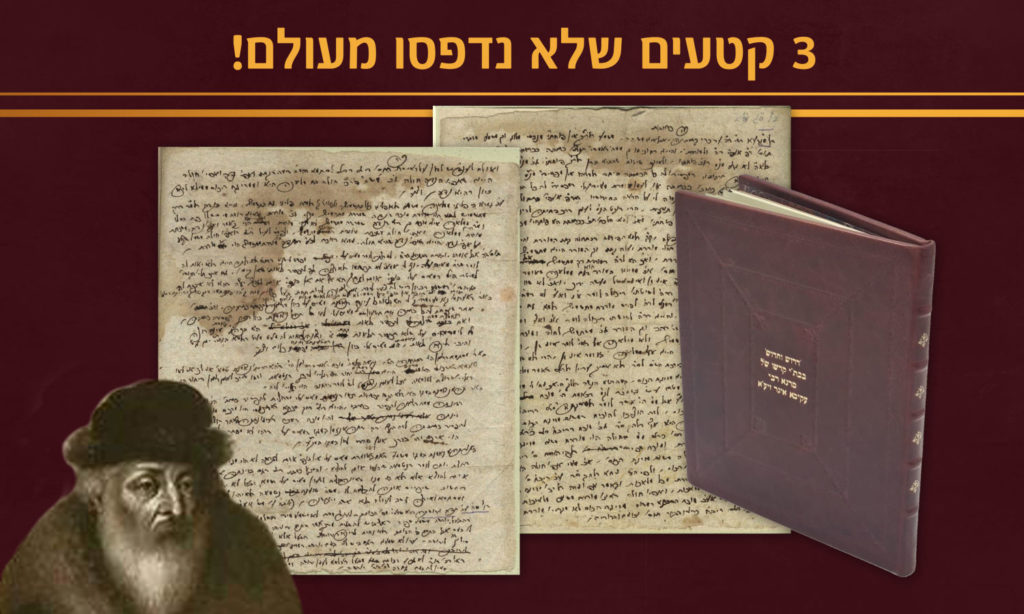
Autograph of the book Drush V’Chiddush – Approximately 1200 (!) words in the very hand of the rabbi of the entire diaspora, the gaon Rabbi Akiva Eiger. The manuscript is in a different style from the printed text and it includes three passages that have never been printed! The entire Torah world is waiting in ready anticipation to view the original manuscript of Drush V’Chiddush and the differences from the printed version, and to read the novellae of that gaon of geonim – Rabbi Akiva Eiger – which were hidden until now (refer to the letter from the gaon Rabbi Sh. Arieli, attached.)
In the introduction to the book Drush V’Chiddush that was first published posthumously, apparently from this manuscript, the author’s two sons wrote that they must say that the wording in the book is not the author’s pure language. The sons write that they edited the words and they write an explanation for this. Indeed, examination of the manuscript version clearly shows differences in the text and the style from those of the printed version, as well as three new passages that – for reasons unknown to us – are not printed at all in the book.
As is known, each and every word that left the gaon Rabbi Akiva Eiger’s mouth was weighed and measured. Rabbi Chaim HaLevi Soloveitchik of Brisk was as particular with Rabbi Akiva Eiger’s words as with the words of the Rishonim (which explains the rare importance of this manuscript). The gaon of Tchebin stated that if the gaon Rabbi Akiva Eiger cites proof from the gemara, one can deliberate his proof, but if he writes from reason, there is no room to debate his words! It is known that for the gaon of Tchebin, there is a difference between the books written from Rabbi Eiger’s writings (such as this one) and the books written by his disciples. The Chazon Ish said about him: “Rabbi Akiva Eiger could have lived in the Rashb”a’s generation, but Hashem had mercy on us and gave us Rabbi Akiva Eiger in our generation.”
A signed opinion is included from the gaon Rabbi Sh. Arieli, who is an expert in Rabbi Akiva Eiger’s Torah. He edited and published many books of Rabbi Eiger’s Torah thoughts, including books that were printed from manuscript. In this opinion, he determines with certainty that this is a manuscript by Rabbi Akiva Eiger, and he writes about the three passages that were not printed: “They are wonderful treasures, not measurable in gold or any currency. The letters from Rabbi Akiva are most sacred gevilim , a treasure trove that all bnei Torah and Talmud scholars crave and long for the day the words will be printed and their thirst will be quenched with living waters from our teacher and rabbi, ztz”l.”
[2] pages, 18×21 cm. Densely written, 35-38 lines per page. Including novellae on Tractate Yevamot (leaves 63-65).
Very fine condition: Aging stains. Uneven margin cropping. Magnificent embossed leather binding.
Pay Attention: VAT should be added to the commission for foreign residents as well.
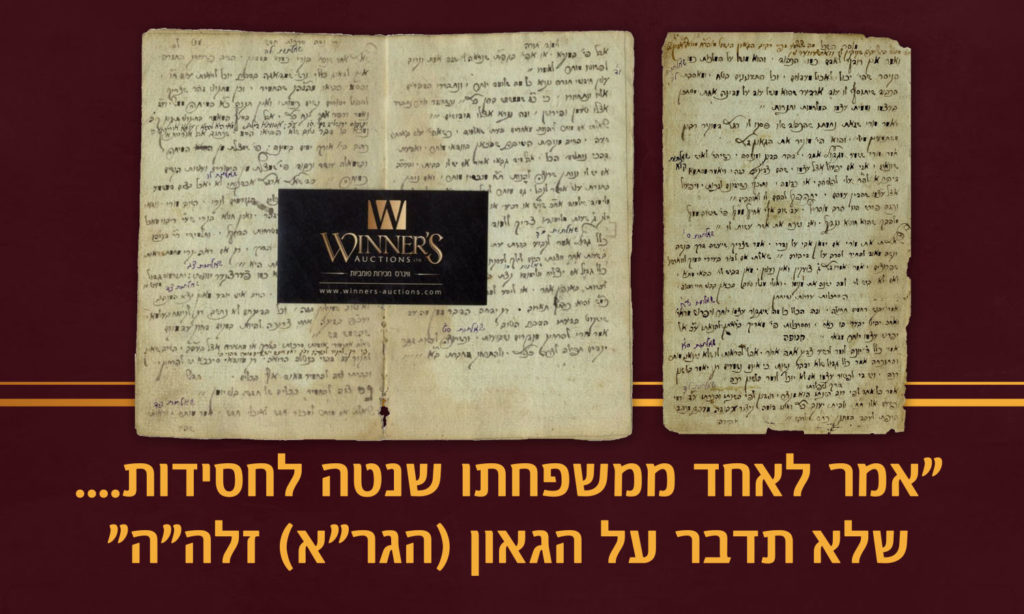
Unique book of responsa consisting of fascinating questions on mussar topics asked of the gaon Rabbi Chaim of Volozhin, and the latter’s responsa. The booklet is entirely handwritten by Rabbi Chaim of Volozhin’s primary disciple, the gaon Rabbi Yosef Zundel Salant – patriarch of the mussar movement and Rabbi Yisrael Salanter’s teacher. A most important and unknown historic discovery in the author of Nefesh HaChaim ‘s mussar doctrine and that of his disciple – the patriarch of the mussar movement. Not printed.
The compilation consists of many dozens of questions asked by the gaon Rabbi Zundel of Salant of his teacher, the gaon Rabbi Chaim of Volozhin, and Rabbi Chaim’s responses (in some of them, the gaon Rabbi Chaim explicitly indicates that he heard the content from his teacher, the Gr”a of Vilna). Most of the responsa deal with the doctrine of mussar and character traits, and constitute an important supplement and addition to Rabbi Chaim of Volozhin’s mussar method as it appears in his monumental work, Nefesh HaChaim (Torah thoughts are poor in one place and rich in another). Indeed, it can certainly be said that in this kuntress, seeds were planted for the ‘mussar movement’ founded by the compilation’s author, Rabbi Yosef Zundel Salant, several years later, who was eventually known as ‘Father of the Mussar Movement.”
In the booklet, there are interesting mussar instructions as well as various segulahs, all from the gaon Rabbi Chaim of Volozhin, for example: “My teacher said that he heard from a rabbinic leader one thing that is tried-and-true: When a person has enemies, if he behaves within himself as if they are righteous and correct, their hearts will turn around and they will come to love him.” Likewise, there is practical advice to be saved from forbidden sights, flattery, useless talk and other bad character traits. Later on in the kuntress, there is a lengthy responsum with respect to a sin done for the sake of Heaven [“גדולה עברה לשמה”], the famous dispute between Rabbi Chaim of Volozhin and the Chassidim, and many more huge discoveries in Rabbi Chaim of Volozhin’s doctrine through his disciple, Rabbi Zundel of Salant. In one of the responsa, Rabbi Zundel describes, from the gaon Rabbi Chaim of Volozhin – leading disciple of the Vilna gaon – his fascinating first meeting with the Gr”a.
Refer to the Hebrew catalog text for a brief biography of the gaon Rabbi Yosef Zundel of Salant .
[14] pp, approximately 11×17 cm. High-quality paper. Clear, legible script.
Fine-very fine condition: Aging stains. Detached leaves. Not bound.
Pay Attention: VAT should be added to the commission for foreign residents as well.
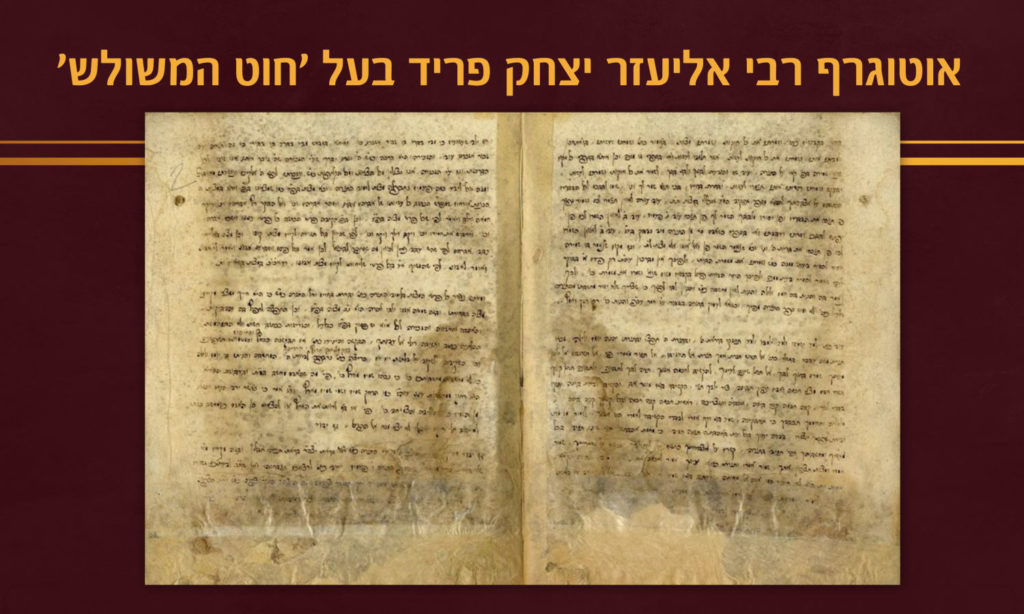
Complete manuscript of the book Ma’alot HaTorah , including the introduction – the wondrous book by Rabbi Avraham, brother of the Gr”a of Vilna. The book discusses the Torah’s virtues and those of its diligent study. In his book, Rabbi Avraham several times cites words he heard from his brother, the Gr”a.
Apparently in the hand of the gaon Rabbi Eliezer Yitzchak Fried, author of Chut HaMeshulash , grandson and successor of the gaon Rabbi Chaim of Volozhin as rosh yeshivah of Volozhin and Av Beit Din of the city.
The manuscript has not been thoroughly examined and a comparison has not been made between the printed and manuscript versions, yet from examination of the book’s introduction only, we have already found a line that does not appear in the printed version: ‘And as elucidated by the Ari, z”l, all issues of fasting, self-flagellation and self-denial were meant for earlier generations, but recent generations are more feeble, and repentance is primarily through strengthening Torah [study] all day …’ The last leaf bears various notations, one of which is regarding charity for the poor of the Land of Israel; its source is in the book Netivot Olam (Lvov, 1807).
Refer to the Hebrew catalog text for a brief biography of the gaon Rabbi Eliezer Yitzchak Fried .
[32] pp, 21×17 cm. Ashkenazic script.
Poor-moderate condition: The condition of the manuscript is damaged and blemished by water. The writing on the bottom third of the leaves is blurred. It is partially torn and lacking. New binding.
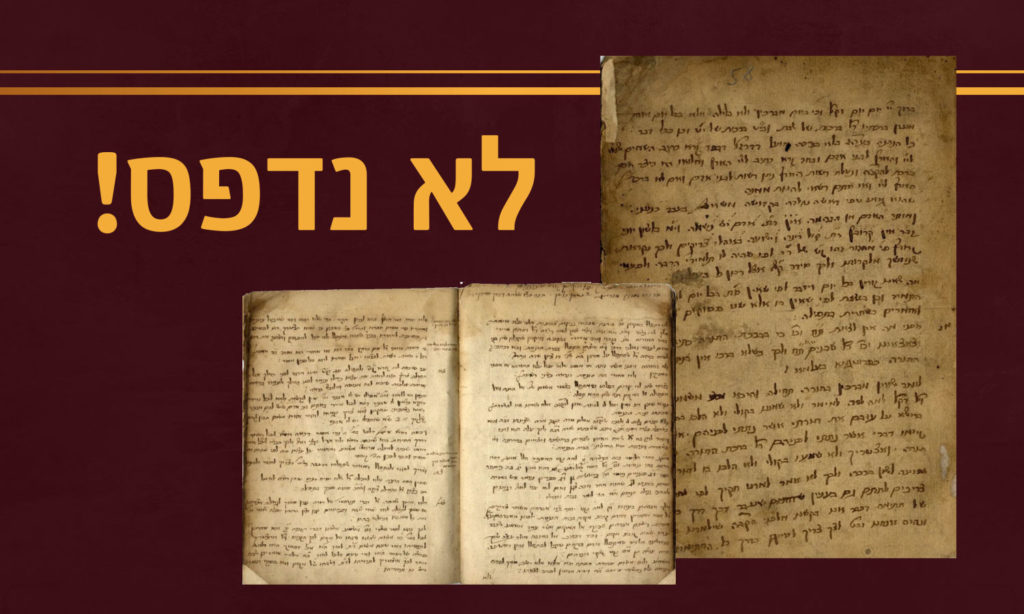
Short commentary on Tur Orach Chayim simanim 45-130. Askenazic manuscript from the 16th century. The style of the writing matches that of the mid-16th-early-17th century.
Written at the top of the final page: “Compilations of commentaries on Tur Orach Chayim.”
Commentaries mentioned only once are: Peirush Mahar”a [Rabbi Avraham of Prague], printed in Augsburg 1640 and Maharara”n, who is Rabbi Nathan Shapira, author of Mevoh She’arim al Sha’arei Dura , who passed away in 1678. His commentary on the Tur was published for the first time in our days in the Tur published by El HaMekorot. He refers to the Beit Yosef as “HaKara” – as he was generally referred to in his generation and the following generation.
[26] pp. 19×14 cm.
Fine condition. Slight tears in the margins, some restored, with almost no damage to text. Light stains. Old jacket cover.
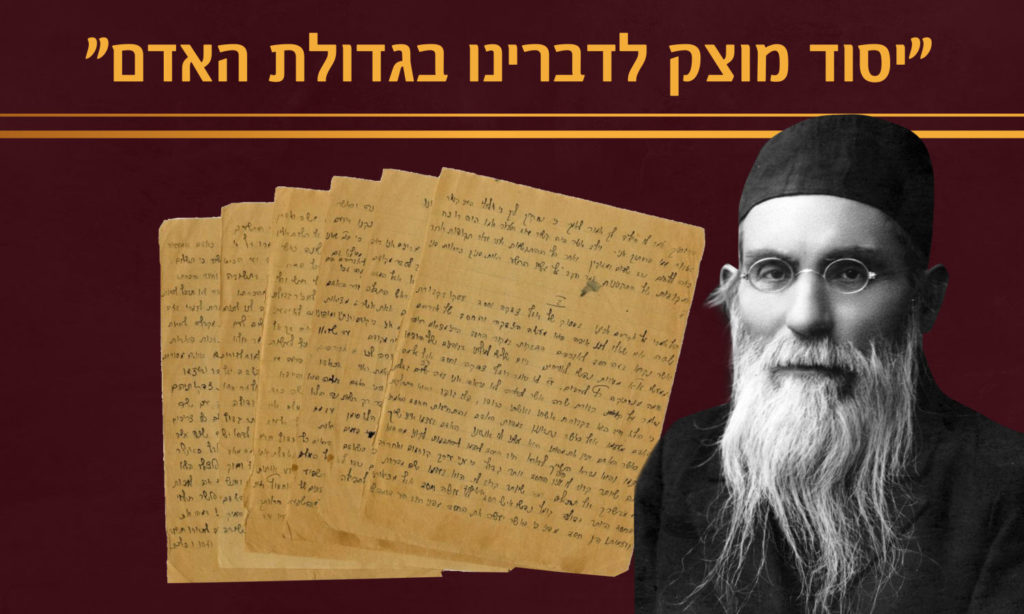
Binder of mussar talks by the Alter of Slabodka, the gaon Rabbi Nathan Tzvi Finkel, patriarch and progenitor of the mussar movement’s Slobodka school of thought and one of the leading rashei yeshivahs in Lithuania and the Land of Israel at the end of the 19th century and the beginning of the 20th century. The discourses are in the handwriting of his disciple and successor, ‘the Kohen, greatest among his brothers, ‘ the gaon Rabbi Aharon Cohen, rosh yeshivah of the Chevron yeshivah.
The binder consists of eight mussar talks by the ‘Alter of Slobodka.’ It opens with a notation by the gaon Rabbi Aharon Cohen: “Words from the mouth of the ‘Alter, shlit”a, Aharon Kagan – from the discourses of Slabodka.” These discourses constitute a summary of the mussar doctrine of the Alter of Slobodka’ principally ‘Gadlut HaAdam’ (The reverse approach to that of Novoradhok, which emphasizes negation and breaking [bad] character traits). The first discourse in the binder already presents us with the essence of the Alter of Slabodka’s method: “A solid foundation for our words on the greatness of man” with the Alter expounding that not only is the spiritual part of man very lofty, but even man’s body expresses Divine wisdom.” This is the way of all these discourses, carefully woven in the unique approach of the Alter of Slobodka’s approach with respect to “Man’s greatness.”
These discourses were written by the leading disciple of the Slobodka yeshivah, the Lithuanian prodigy, ‘Rebbe Archick Kovner (the gaon Rabbi Aharon Cohen), who later married the daughter of the rosh yeshivah of Slobodka (the gaon Rabbi Moshe Mordechai Epstein, the Alter’s in-law). He also became head of the yeshivah in the Land of Israel, which was already known by its new name: Yeshivat Chevron. The discourses, which were written precisely as delivered by the Alter of Slabodka when he gave them in the hall of the yeshivah, and especially as they were written by the gaon Rabbi Aharon Cohen, who was known for his astonishing genius and his extensive precision with each word, constitute a unique and authentic source of the Alter of Slobodka’s doctrine, who, as is known, did not leave writings behind; his philosophies and methods were printed solely from writings by other disciples. We have found innumerable differences, primarily in style, but occasionally also in the meaning of the topic itself.
Refer to the Hebrew catalog text for brief biographies of the geonim Rabbi Nathan Tzvi Finkel and Rabbi Aharon Cohen and a brief discussion of the Slabodka school of thought .
[1] lined notebook, [12] written pages. Approximately 15×21 cm.
Fine condition: Very detached leaves. Jacket cover. The back cover is lacking.
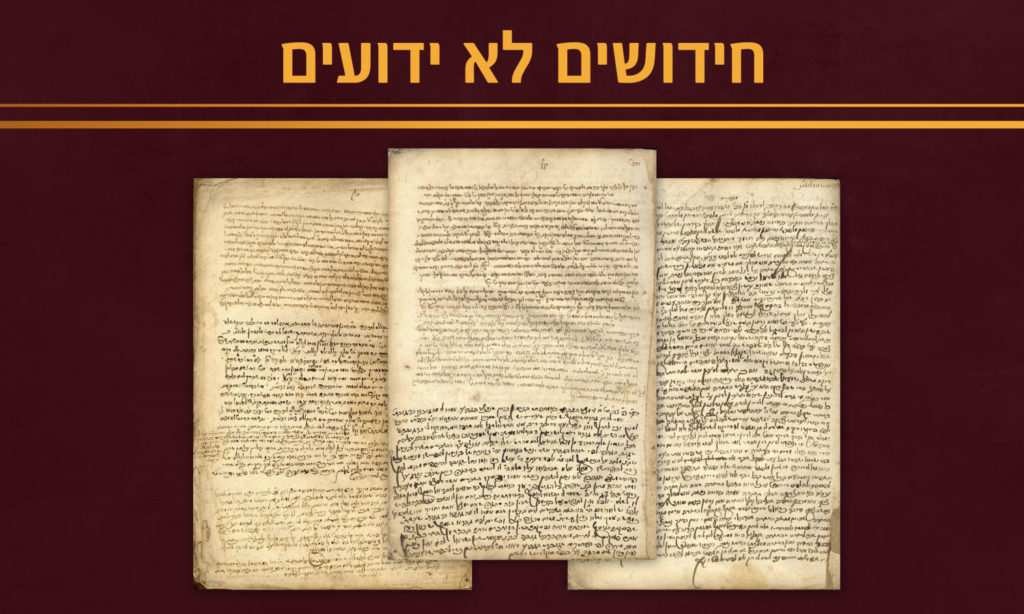
Complete early Ashkenazic manuscript (approximately 200 large pages) from the beginning of the 18th century. This manuscript consists of elucidations on the entire Torah and our Sages’ midrashim in the order of the weekly Torah portions, with elucidations on the megillahs at the end. Extremely important manuscript.
The identity of the author does not appear in the work and is unknown to us, yet it is clear from the style and the content that the author was a Talmudic scholar and great expert even in the more recent books of commentary. In several places, the author’s Kabbalistic expertise is evident as well (refer to page 85a where the author has a lengthy list of abbreviations with various messages that work out from the words ‘תשובה’ and ‘תפילה’).
The author’s period and location are gleaned from the fact that he refers here and there to books of sermons and commentaries by several rabbis from Ashkenaz (apparently) from his generation: Tiferet Shmuel , Tiferet HaGershuni , Pnei Aryeh , Nachalat Azriel , Yad Avi Shalom . These are all books of expert sermons printed c. 1800.
Another hint to the author’s identity appears on page 43b, where the author indicates a wondrous aggadic novellum in his father’s name: “Refer to Chiddushei Aggadot by my father, z”l, in Tractate Sotah, leaf 27, stating that Moshe broke the Decalogue so that he too would be a sinner and able to pray …”
[1] large bound ledger, 118 leaves. 30×19 cm. There may be some leaves lacking.
Fine condition. Aging stains. Slight tears (some are reinforced and restored) with slight wear to the corners of several leaves.
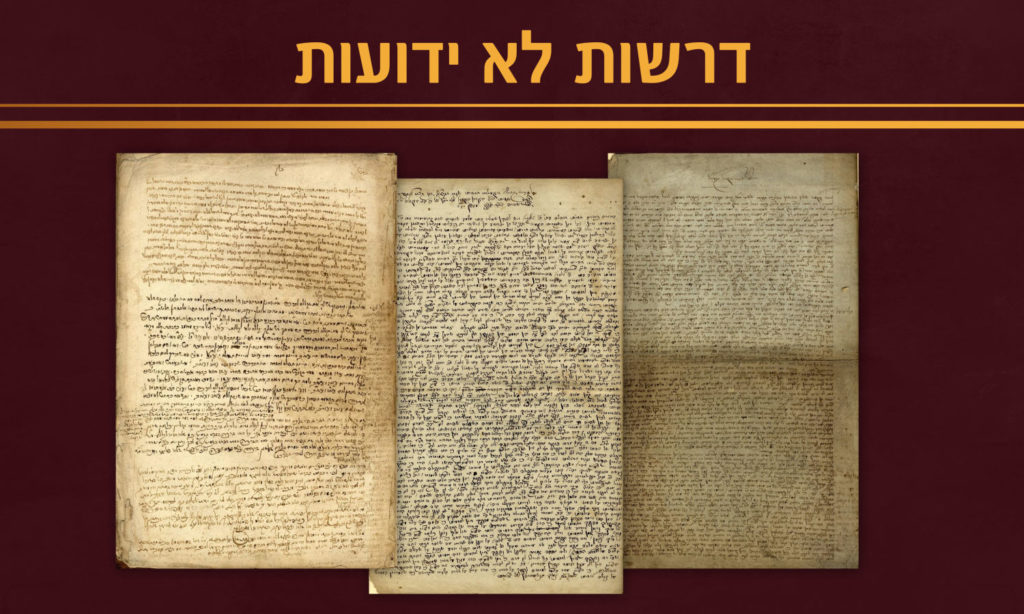
Manuscript- sermons for Shabbat HaGadol and eulogy for the gaon Rabbi Hertz Shaier, written by a rabbi in one of the communities in the Mainz district.
The manuscript includes [11] sermons for Shabbat HaGadol that were delivered between the years 1819-1831, and another sermon [p. 11a]: “For the Chevra Kaddisha Gemillut Chassadim 1823 with a short eulogy for the pure and righteous gaon, rabbi of the entire Diaspora, Rabbi Hertz Shaier ztz”l, who was the Av Beit Din in Mentz.”
From the eulogy, it appears that the person who delivered it was close to the gaon Rabbi Hertz, possibly his disciple. He mentions in the eulogy that he had previously lived in Mentz “and I heard his Torah” and that he was then a resident of Wally (in the Mainz district) where questions would be sent to Rabbi Hertz. He also mentions some of Rabbi Hertz’s Torah thoughts in the eulogy.
Approximately [32] pp. 35×21 cm. Ashkenazic script, rabbinic, cursive and beautiful.
Fine condition: Aging stains, slight tears and creases in the margins. New binding.
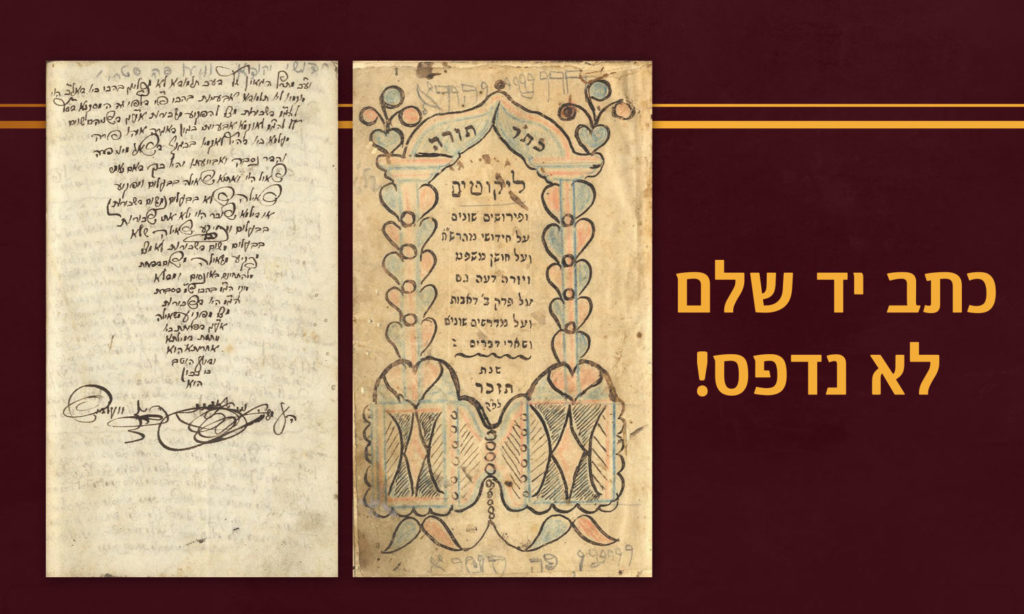
“Compilations and commentaries on Chiddushei HaMaharsh”a , and on Choshen Mishpat and Yoreh Deah, also on the second chapter of Avot and various midrashim and other matters” (text of the title page). Complete work in a clear and beautiful script by one of the geonim of Galicia.
The title page bears a colorful decorative border with pillars and flower vases. At the top is the decorative headline “Keter Torah, ” and this may be the title of the work.
At the end of section 39 of the novellae on Choshen Mishpat (p. 44b), the following is noted: “This was stated by Rabbi Zalman Mishel, dayan of Balchov [author of Otzrot Shlomo al Treifot HaReiah (Lvov, 1841)]. He passed away in 1857 and was eulogized by Rabbi Menachem Mendel Panet in the latter’s book Ma’agalei Tzedek Part II, page 79a].
210 leaves of which approximately [330] pages are written. 17×10 cm.
Fine condition: Minimal tiny worming perforations. In the final leaves, there are stains in the upper third and minimal tears, most without lack. New semi-parchment binding.
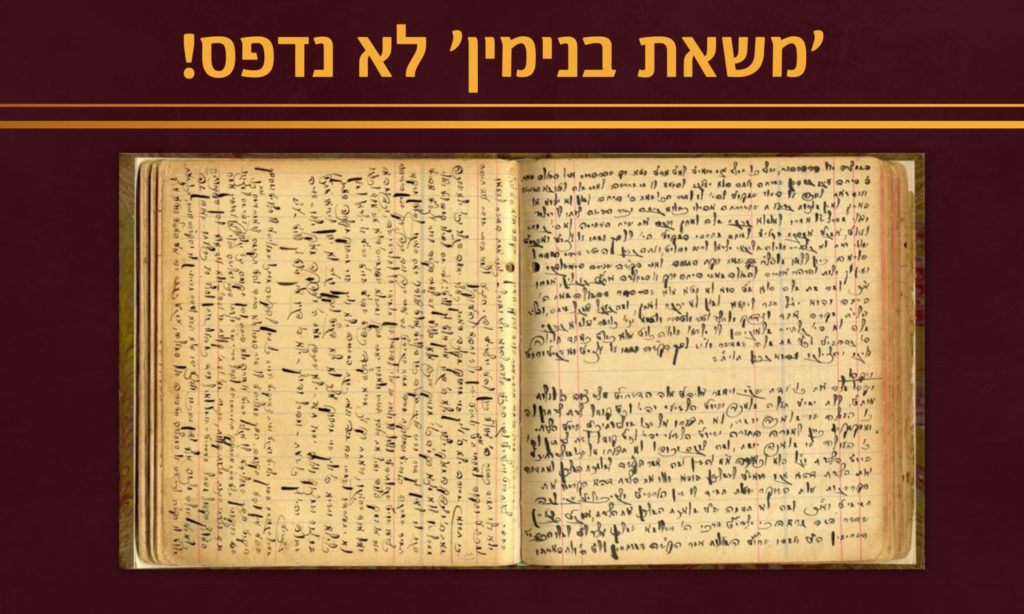
The book ‘Mas’et Binyamin’ contains wondrous elucidations on the Torah portions including many elucidations of wondrous midrashim and elucidations of the mesorah . Thick volume covering over 250 pages, entirely in the hand of the gaon Rabbi Eliyahu Reich, dayan of Tirna. This manuscript constitutes a continuation to his renowned book Mas’et Binyamin and it has never been printed.
This manuscript includes elucidations and sermons that were delivered 1918-1925, after the completion of the printing of his books Mas’et Binyamin (1908-1914). In his novellae, Rabbi Eliyahu mentions material from his rabbis “… the great gaon Av Beit Din P. B. and other Hungarian sages. Pages 61-66 bear ‘Tziyunei Derashot al Pirkei Avot’ which are chapter headings. These match his major commentary on Pirkei Avot, Prachei Ezov (Galanta, 1927) and this is definite proof of the author’s identity. (There is also a letter signed in a foreign language on page 126b).
The gaon Rabbi Eliyahu Reich [1870-1945] was a disciple of the geonim, the author of Shevet Sofer and Rabbi Yehudah Greenwald, Av Beit Din of Satmar, author of Zichron Yehudah . He served as a dayan and preacher in Tirna from 1904 until he was murdered during the Holocaust, apparently in Tishrei, 1944. His printed works include: Mas’et Binyamin and Prachei Ezov (for more, refer to Kinstlicher, HeChatam Sofer V’Talmidav , p. 558).
[256] pp, 16.5 cm. Some are written across the width of the leaf.
Fine condition: Slight blemishes in the margins of a few leaves. New binding.
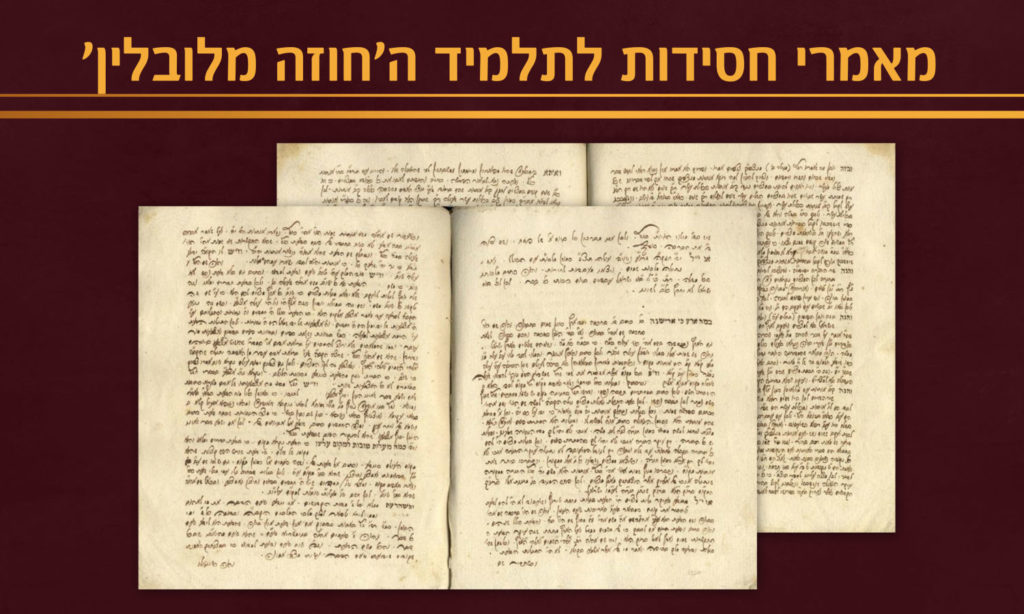
Chassidic and Kabbalistic essays on the weekly Torah portions, for the Passover festival and on the Haggadah service, by Rabbi Aryeh Yehudah Leib of Lantzhut and Kishinev, one of the leading disciples of the Seer of Lublin, the author of Arba’a Charashim , Chomat Ariel , Gevurot Aryeh and more.
Most of the essays were printed in the author’s books, with differences. The author’s novellae were only printed several decades after his passing, from writings that were dispersed among his disciples and they were printed in no particular order. Superficial examination shows that there are passages in the manuscript that have not been printed in the books. It may be that the copyist wanted to create an orderly book, and gathered material from the author’s books, and he may have had additional writings.
Page 20b bears words heard by the author from the maggid of Kozhnitz.
Complete and orderly manuscript, with highlighted beginnings of the paragraphs, with a page protector and nice margins.
Refer to the Hebrew catalog text for a brief biography of Rabbi Aryeh Yehudah Leib of Kishinev .
53 leaves, written on both sides of the leaf. 23 cm.
Very fine condition.
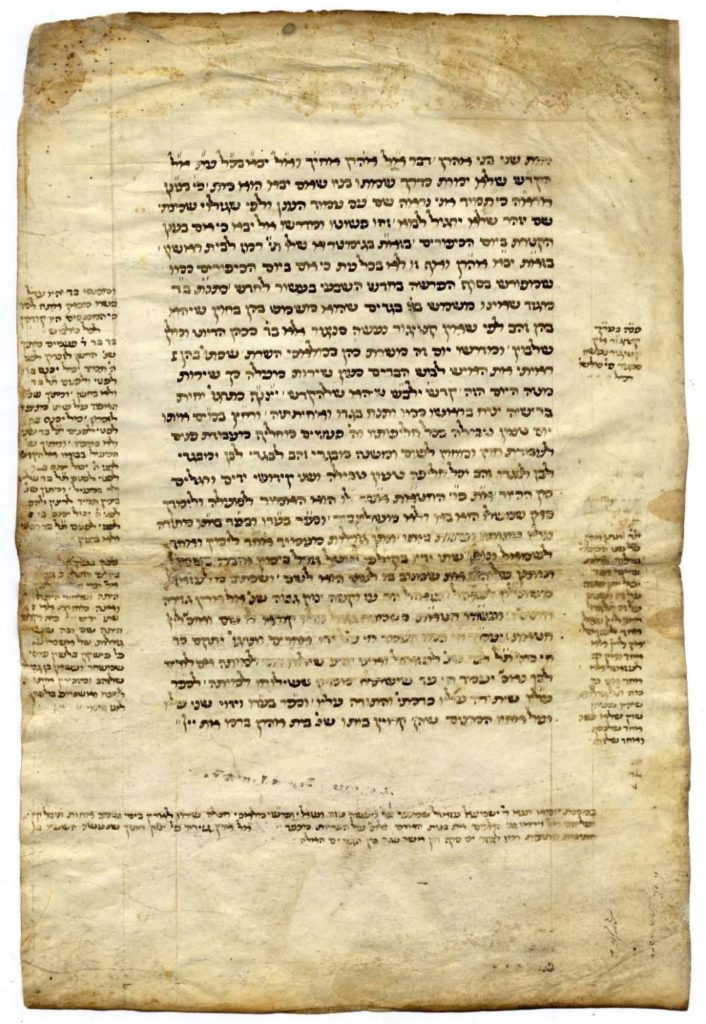
Manuscript on parchment removed from its binding. It is a copy of Rash”i’s commentary on the Torah, on the portion Acharei Mot. With differences from the printed version.
[1] sheet of parchment 31.5×21 cm. Written on both sides.
One side is VaYikra 16 verses 1-11.
The second side is Vayikra 16 verses 12-23. There is an unknown ancient commentary in the margins of the page.
Moderate condition. Stains. Faded script. For the most part legible.
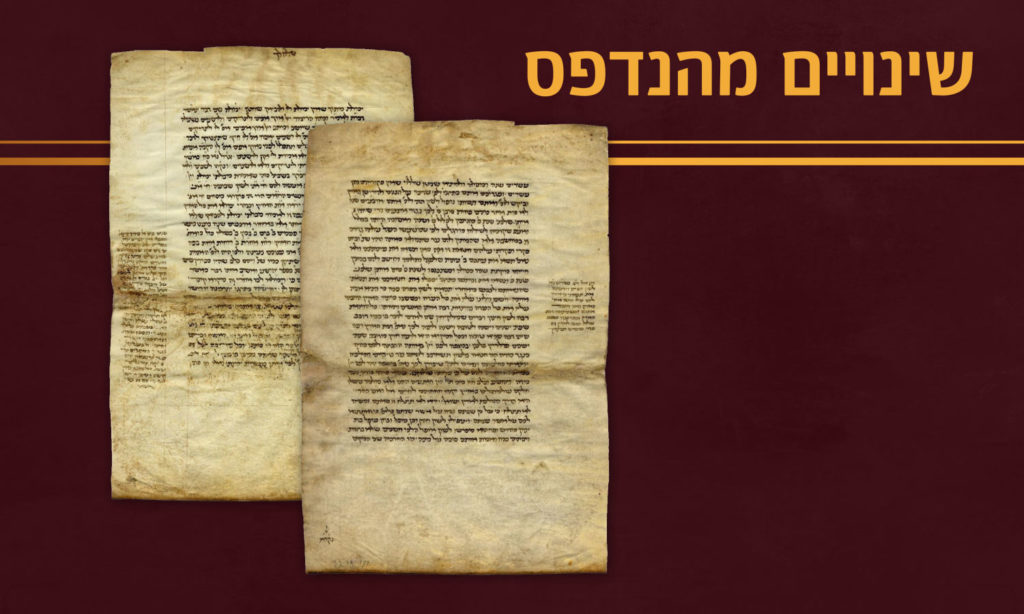
Manuscript on parchment removed from its binding. It is a copy of Rash”i’s commentary on the Torah, on the portion Shlach. Many differences from the printed version.
[1] sheet of parchment 31×21 cm. Written on both sides.
One side is Bamidbar 14 verses 16-29.
The second side is Bamidbar 14 verses 29-45. There is an unknown ancient commentary in the margins of the page.
Moderate-Fine condition. Stains. Faded script. For the most part legible.
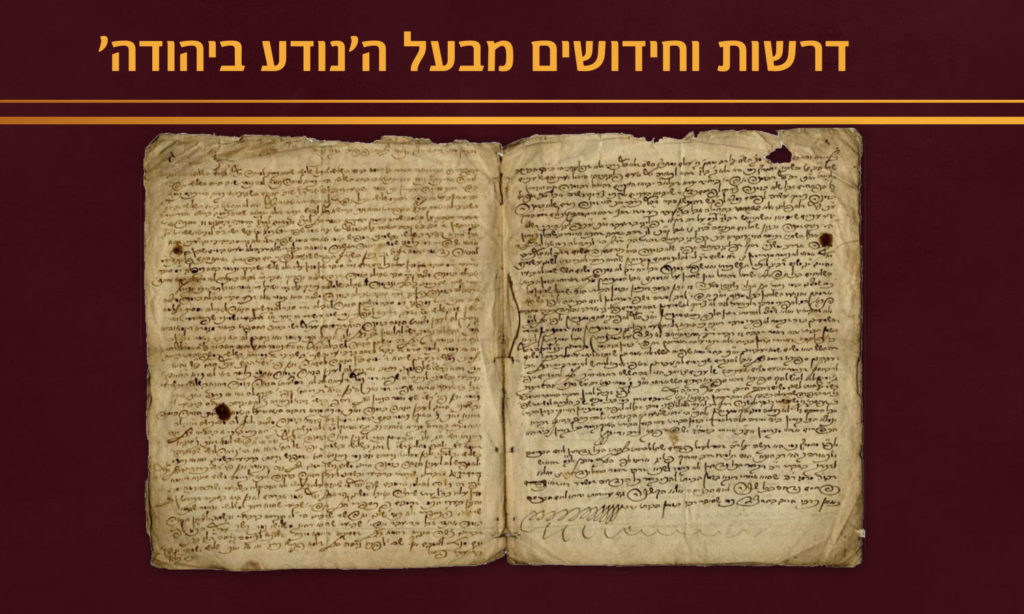
Handwritten compilation including sermons and Torah novellae in the names of the geonim of Prague, led by the gaon Rabbi Yechezkel Landau, author of Noda BiYehudah , renowned rabbi of Prague. We have not checked whether these novellae by the Noda BiYehudah were printed in his books Tzla”ch or Doresh LeTziyon .
1. By the gaon Mohari”l [Rabbi Yechezkel Landau] on the first day of Passover.
2. In the name of the gaon Mohari”l [Rabbi Yechezkel Landau] Segal, relating to Purim.
3. By the gaon Rabbi Zerach Eidlitz, delivered on Shabbat Parah 1772, leaf 3a.
4. In the name of the gaon Rabbi Zalman Emrich Daynah, rabbi of Prague [author of Shishah Zir’onei Arugah ] relating to ritual circumcision.
[8] pp, approximately 19×23 cm. Clear penmanship.
Moderate-fine condition: Aging stains. Slight wear at the tops of the leaves with damage to individual words. Slight fading in the writing on the last page.
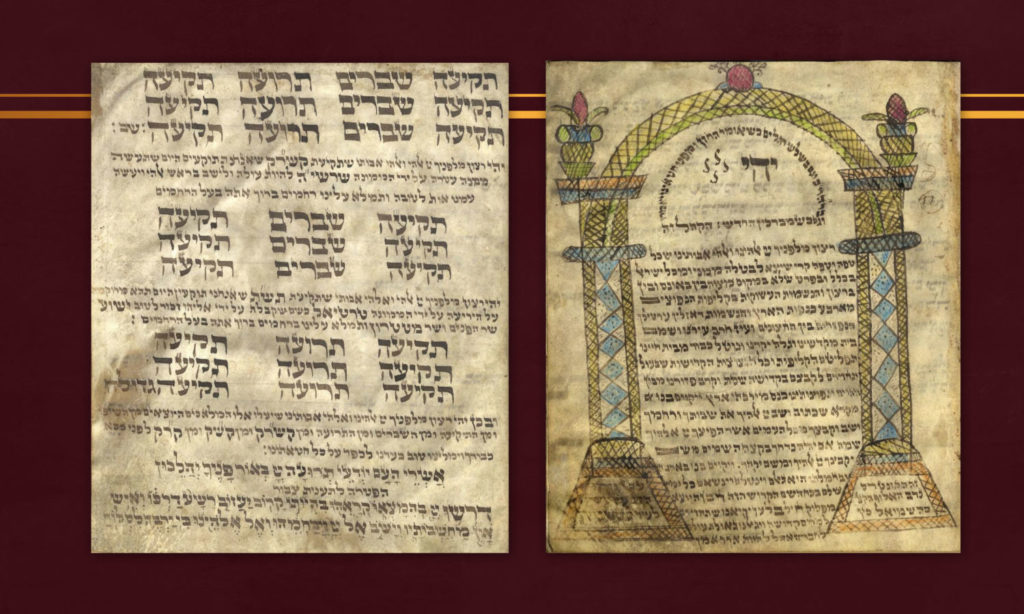
Siddur in script on parchment for the chazan of the Lentshitz community.
Written by a scribe in large illuminated and vowelized letters, with a color illustrated title page. Prominent titles and more.
The siddur includes various prayers, hymns, different requests for the holidays and more. Birkat HaChodesh . Birkat HaGomel . MiSheBerach for the ill. Lecha Dodi . Blessings for the haftarah. Birkat HaNoten Teshuah for royalty and government for princes. Blessings for the three pilgrimage festivals. The Yizkor prayer. E-l Maleh Rachamim . Blessings for Mondays and Thursdays. Blessings for the megillah and for after the megillah reading. Prayer for the intentions for shofar-blowing.
The title page is decorated in color, with a pair of pillars, an arch, and decorative blossoms and flowers. On the title page, there is a prayer for the known sin, yehi ratzon shekol … [‘יהי רצון שכל טיפה וטיפה קרי שיצא לבטלה ממני ומכל ישראל’.. ]. At the base of the pillars, there is an inscription with the name of the donor, from Leshintz.
[16] leaves. 20×23.5 cm.
Fine-very fine condition. Aging stains. New leather binding.
Pay Attention: VAT should be added to the commission for foreign residents as well.
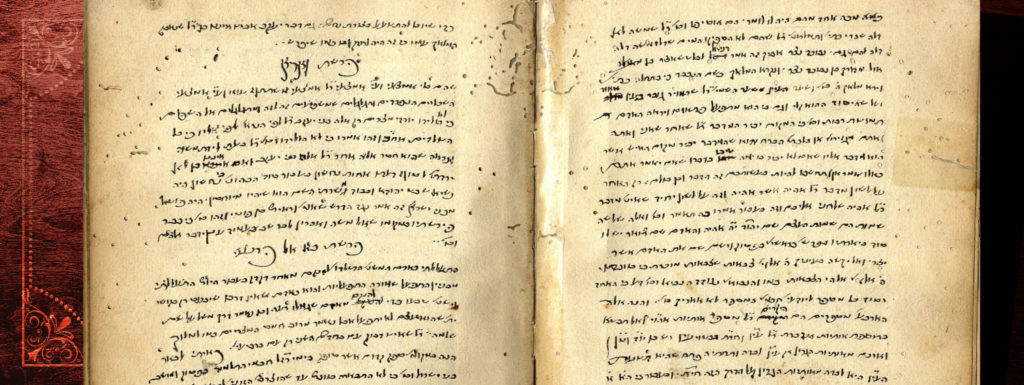
Large manuscript – early transcription of the book Ot Nefesh – an elucidation on the Ibn Ezra’s commentary on the Torah. Tirna, c. 16th Century.
As known, the Ibn Ezra’s commentary on the Torah is considered one of the most important and fundamental elucidations of its verses. His method was to explain the verses according to their simple meaning, as he indicates at length in his preface to the Torah. In certain places, he is very brief, and his words are difficult to comprehend. Dozens of books have been written to explain his intent. This manuscript deals entirely with explanations of the Ibn Ezra’s elucidation with faithfulness to the accepted method of commentary and an expert in-depth scholarly understanding and total mastery of all realms of Torah.
Leading researchers are uncertain to this day as to the authorship of this commentary. There are those who attribute it to the Ralba”g, and those who say that Rabbi Yedayah HaPenini wrote it, and those who claim it was Asher Karkash. Copies of this book are found in prominent libraries around the world. This important work has only recently been printed (after 1971) by comparison of this copy and the copy in the British Museum. There are differences here from what was printed in the book.
The transcriptionist’s signature appears at the end of the work: “G-d, having granted me the privilege of writing this elucidation, allow me to study it and other sefarim without limit, signed, Yoel bar Yosef of Tirna.”
114 written pages. 20 cm. Early Italian autograph script. Glosses on several leaves.
Moderate-fine condition. Thick, high-quality leaves. Many old worming perforations. Aging stains. New binding with matching slipcase.
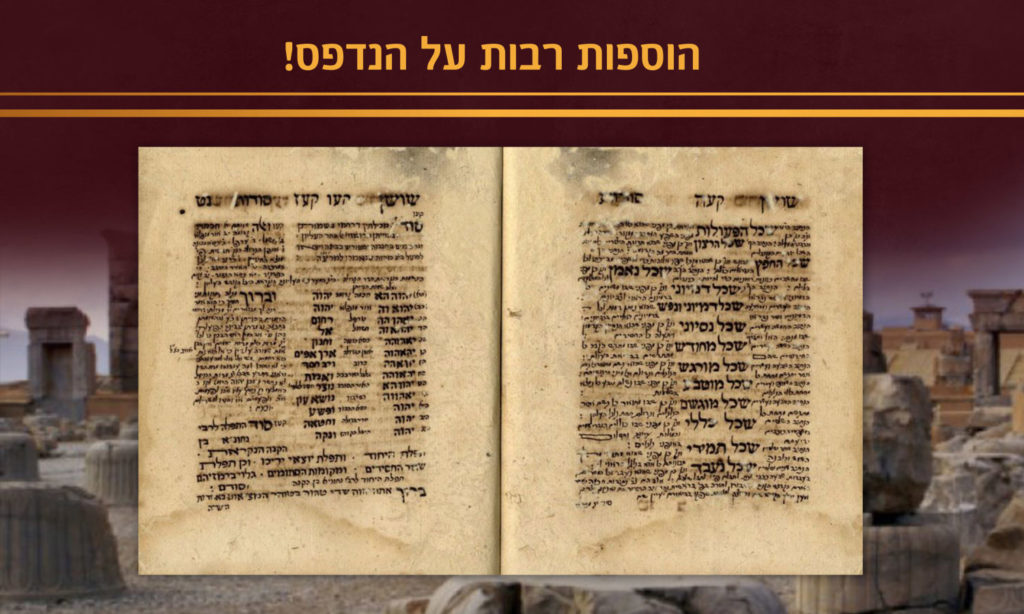
Wonderful and deep secrets about the intentions in prayers and blessings by Rabbi Moshe who was exiled from Kiov. Early manuscript with many differences, including entire paragraphs, and many illustrations and tables that do not appear in the printed book.
The book is called Shoshan Sodot due to its originally containing 656 secrets, the numerical value of Shoshan [שושן]. In fact, the printed work only includes 463 secrets, and this manuscript includes 491 secrets.
There are various opinions as to the author’s identity, including: The Rama”h, the Ramba”n, the Ramba”n’s disciple and the Ramba”n’s grandson. This has been thoroughly investigated and it has been resolved that the author is Rabbi Moshe B., who is Rabbi Moshe who was exiled from Kiov. [Refer to Shem HaGedolim by the Chid”a in the entry on Shoshan Sodot. ]
This Rabbi Moshe was born in 1449 in Lithuania. For several years, he was a resident of Kiov, which in those days was home to a large and prominent Jewish community. In 1495, Jews were expelled from Kiov and R’ Moshe went into exile, hence his name: ‘Rabbi Moshe who was exiled from Kiov.’ In 1506, when he was in the city of Lida, the Tatars attacked the city and plundered it, and Rabbi Moshe was taken captive to their country, Crimea. The Crimean Jews redeemed him and he became their leader.
This book started to be written in the year of exile, 1495, and was completed in Crimea in 1511. The author passed away in 1520. [ Ohel Rache”l Part I pp. 93-94].
The book was first printed in Koritz, in 1784. We have not carried out a precise comparison between the printed version and the manuscript.
This manuscript apparently predates the printed version, given that aside from the pagination, there are booklet paginations, which may indicate that the book was used as a preparation for printing.
Ashkenazic script, clear and orderly. [132] leaves. Size: 16×18 cm. The manuscript starts on leaf 6 and ends with leaf 138, and contains secrets 20-491. Few Kabbalistic tables and diagrams.
The book is in fine condition with the exception of tears and worming perforations that have been professionally restored with damage to text. Not bound.
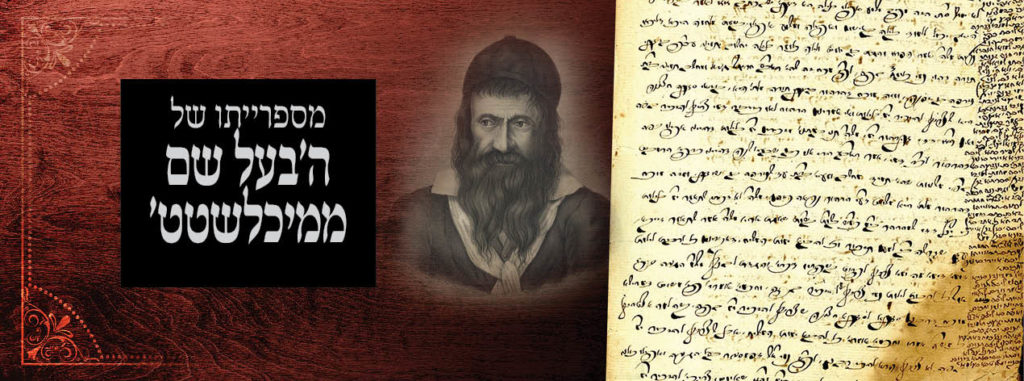
78-page booklet handwritten by the gaon Rabbi Pilta Epstein Segal – disciple and assistant of Rabbi Yedidyah Tiah Weil, with novellae and sermons in the order of the Torah portions and annual holidays, combined with Talmudic and halachic novellae. Beautiful, clear script, with pretty calligraphic flourishes. Table of contents at the end. The manuscript is dated in several places, throughout the months of 1804.
The source of this manuscript is from the library of the sacred Kabbalist Rabbi Zekkel Leib Wormser, the ‘Ba’al Shem’ of Michelstadt, and was passed down through his descendants to this day.
This manuscript contains several mentions of prominent rabbis:
On leaf 27 – ” However, I heard in the name of the gaon Rabbi Netanel Weil … ”
Page 33b: ” I heard from the gaon Rabbi Moshe son of the famous gaon Rabbi Shmuel, av beit din of Amsterdam (!)…”
Leaf 38: – “I heard in the name of the gaon Rabbi Yosef Steinhardt [ av beit din of Furth, author of Zichron Yosef , Furth, 1773].
Refer to the Hebrew catalog text for a brief biography of the gaon Rabbi Pilta b”r Moshe Segal Libold-Epstein .
39 numbered leaves, 78 written pages. 33 cm.
Moderate condition: Stains, tears and many missing parts in the first and last leaves. Not bound, many leaves are detached.
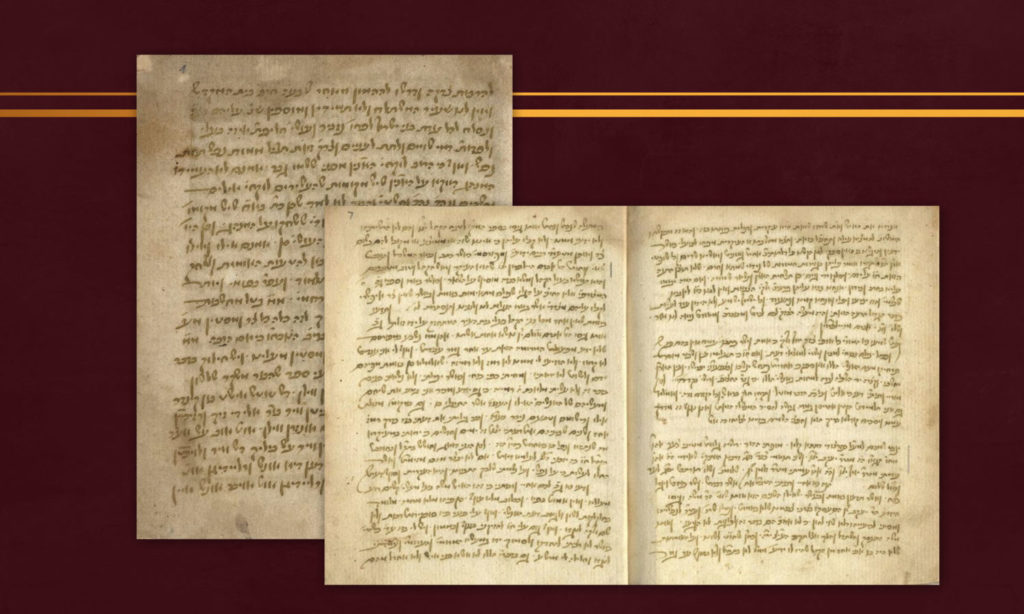
Rare manuscript, apparently from the 15th-early 16th centuries with two parts: Response to claims by the apostate Pfefferkorn, and the controversy in the Ulma community. Extremely important and interesting manuscript, with an interesting historic revelation.
* The first part [pp. 1-9]: Response to claims by the slanderous apostate, Pfefferkorn. He was a famous apostate, also known in this manuscript as TK [-treifah katzav (butcher)] who caused Jews to stumble and fed them carrion and treifahs, may G-d have mercy. This apostate, together with a friend among his associates the Dominican priests, printed several books inciting against Jews. In his second book, Juden Dichte [ Jews’ Confession ] printed in 1508, he mocks the custom of kapparot and other Jewish customs – and as a response opposing him, this compilation was composed [Refer to Y. M. Peles, Tzfunot 5 p. 17]. In Peles’ opinion, this author of the compilation is Rabbi Yochanan Luria, author of Meshivat Nafesh . Lacking the beginning.
* The second part [pp. 9-16] is a lengthy letter from Rabbi Moshe of Lichtenfels to the geonim and leaders of the country. In his letter, a resident of Ulma complains about a scholar, leader, one of the community’s wealthy and member of his own family, who took control of ritual slaughter, taking power with force and not honestly. Rabbi Moshe’s language is that of scholarship spiced with Talmudic rhetoric. The final leaf bears an additional passage from the letter about the aforementioned controversy.
Important historic revelation: The letter, as stated, was written by Rabbi Moshe of Lichtenfels. His name is known from a declaration written in 1467 regarding the study of Moreh Nevuchim and his reservations with several interpretations brought there. The declaration was publicized by Ch. Frankel Goldschmidt in the introduction to Sefer HaMakneh by Rabbi Joselmann of Rosheim (p. 22), where she brought the hypothesis that Rabbi Moshe of Lichten is actually Rabbi Moshe Tzart, mentioned by Rabbi Joselmann of Rosheim as rabbi of Ulma, who was forcibly converted to Christianity and then fled to Jerusalem where he publicly returned to Judaism. This conjecture was accepted by several later scholars [refer to the enclosed material]. However, from this letter, we clearly see that this is an error and these are two distinct sages named Rabbi Moshe, as Rabbi Moshe Tzart is mentioned twice!! in this letter from Rabbi Moshe of Lichten (pp. 5, 6).
[16] pp, 14×17 cm. Thick, high-quality paper. Hebrew and ancient Yiddish-Deutch. Apparently copies.
Fine condition. Stains. New binding.
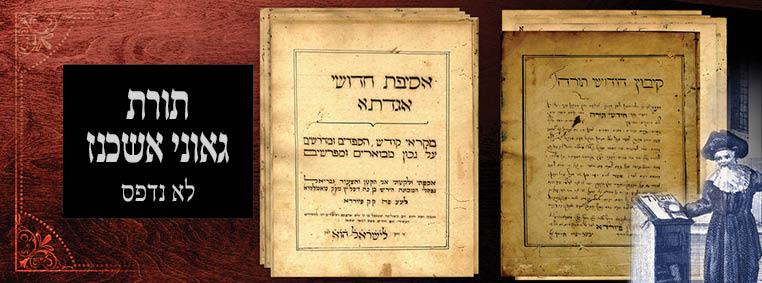
Volume including two different works handwritten by the gaon Rabbi Gavriel Naftali Hirsch Lipman, av beit din of Aurich and Kissingen, during his studies at the famous yeshivah in Fürth under the great Torah leaders, the geonim Rabbi Yehudah Leib Halberstadt, the rosh yeshivah, and Rabbi Wolf Hamburg, av beit din of Fürth. 1822-1824.
The first part is called Kibbutz Chiddushei Torah and it is comprised of 52 pages with a dedicated title page where the writer signed his name – ” The youth Gavriel Naftali Hirsch son of Rabbi Zissel of Amelsdorf presently in Fürth … about the Yeshivah. Friday, the 28th day of the sixth month הבינני ואצרה תורתך [chronogram corresponding to 1822].
This part includes [approximately 14] scholarly topics from around the Talmud that the writer heard from Rabbi Y. Halberstadt and Rabbi W. Hamburg. At the top of each article is the name of the person who delivered the lecture, and the date.
The second part is called Aseifat Chiddushei Aggadeta – Mikraei Kodesh – eulogies and midrashim, properly elucidated and explained. It includes [53] pages with a dedicated title page. Written in the year ‘לישראל הוא’ – a chronogram corresponding to 1823.
This part includes a lengthy eulogy [approximately 6 leaves!] delivered by Rabbi Zalman Ber, rosh beit din tzeddek following the passing of Rabbi Ya’akov Shmuel, av beit din of Schwarzwald and Krappfeld, a eulogy delivered by Rabbi Yehudah Leib Halberstadt after the passing of Rabbi Zalman Ber, head of the Fürth beit din , a eulogy delivered by Rabbi Yehoshua Moshe, rosh beit din of the Fürth community upon the passing of Rabbi Hertz Schaier, av beit din of Metz, Novellae on the weekly Torah portions and more. There is a difficulty presented on leaf [1], along with a wonderful resolution “in the name of the av beit din of Poznań …” – none other than the great gaon Rabbi Akiva Eiger. Most of the eulogies are dated, and some include historic details about the deceased. This section concludes with a song and several leaves in Yiddish.
Rabbi Gavriel Naftali Hirsch Lipman [1805-1864] was one of the closest disciples of Rabbi Wolf Hamburg’s (Ohe”v). Rabbi Wolf mentions him in his books several times with superlative words of praise despite his youth. He served in the Aurich rabbinate and then in Kissingen. He became widely known for his in-depth research into the teachings of Rabbi Avraham ibn Ezra, and also edited and published many books by him.
Background: The Fürth yeshivah was one of the most prominent yeshivahs of its time. It is known that even the Chatam Sofer considered moving his yeshivah to Fürth to unite with the yeshivah there. This volume was written 1822-1824. At that same time, a tremendous battle broke out against the Reform plots, and government authorities opposing the very existence of the yeshivah. In Tammuz 1824, the Reform managed to convince the government to close the yeshivah, and a government order was issued to promptly and completely shutter the yeshivah. The students were required to stay under ‘house arrest.’ The students who were not residents of Fürth were required to leave the city. In the end, after direct intervention by Baron Rothschild, this order was rescinded. For more about the yeshivah, refer to: HaYeshivah Haramah B’Fürth (Bnei Brak 2010). The third volume discusses this affair extensively.
At the beginning, Rabbi Gavriel wrote down Torah thoughts on whatever paper was available and wrote according to his stream of understanding, in a disorderly manner. After some time, he went back and arranged and edited this material into a book, carefully selected and proofread, in beautiful, pleasant-to-read script. This is that prepared volume, and among its leaves are [10] pages of the original writing.
21.5 cm. The volume includes a total of [115] written leaves. Entirely legible.
Moderate-fine condition. Aging stains. Worming tunnels and perforations (with light damage to text), primarily at the beginning of the book and at its end. Detached leaves and compilations. Original simple binding. Slightly blemished.
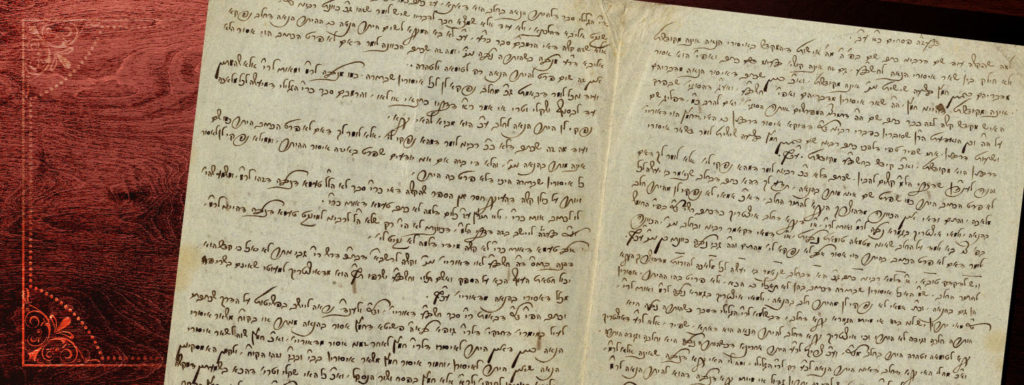
Collection of writings. Including novellae on Talmudic subjects and topics from the Ramba”m, and elucidations on the weekly Torah portions and festivals, and the Passover Haggadah.
There is a date indicated at the beginning of the manuscript: “This morning, Monday, 9 Kislev, 1822,” yet it appears from the leaves and the style that the novellae were written over a long period of time.
The writer’s identity is not known to us, but he was certainly an accomplished person and a rabbi of his community. For example, the sermons for Shabbat Shuvah, Yom Kippur and an introductory Torah sermon – appear to have been delivered to his community. One place mentions the Chatam Sofer’s responsa. One leaf bears a responsum to a question that was asked. On one leaf, he indicates that he wrote at length on the subject in a different place, and in another place, he writes, ‘I saw it in my brother the gaon, ztz”l’s manuscript.’
[112] pp, Various sizes.
Overall very fine condition. The leaves are not bound.
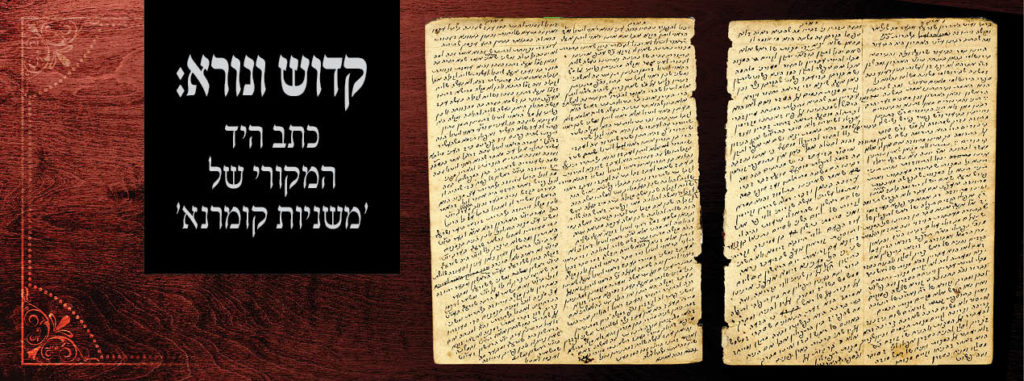
“Yesterday I did something I shall call … Netanel ben Tzoar, and I completed Nachshon ben Aminadav …” (from the manuscript of
Parshat HaNesi’im )
Two pages from the renowned segulah book
Mishnayot Komárno that contain approximately 1500 (!) words handwritten by the Admo”r Rabbi Yitzchak Isaac Safrin, author of
Heichal HaBerachah of Komárno – one of the leading Admo”rim of all generations.
Alongside the huge historic value of these pages, as an original autograph of the famous Chassidic segulah book, they also comprise a real Chassidic amulet for wealth, a spouse and offspring. These passages are from Chap. 5 of Tractate ‘Ma’aser Sheni, ‘ the chapter that deals with tithes including the most important Torah blessings: “Look down from Your heavenly abode and bless the Jewish people with sons and with daughters, with dew and rain and with livestock offspring, as You swore to our forefathers, a land flowing with milk and honey.” (Chap. 5, Mishnah 13), the passage from which our Sages deduce the famous blessing for wealth, “You shall surely tithe … Tithe, so that you will become wealthy”! Following this, handwritten here many times by the author of Heichal HaBerachah , are the expressions and blessings: “Brachah” and much more.
In the middle of this manuscript, the Heichal HaBerachah writes about Parashat HaNesi’im, and the Rebbe cites words in this manuscript from this passage itself and also the names of several of the nesi’im . Chassidic luminaries reveal to us that Parashat HaNesi’im, (and certainly as handwritten by one of the tzaddikim of the generations dealing with this parashah) is a segulah for wealth, and in Chassidic synagogues, the price of the nesi’im aliyah skyrockets. As is written in Igra D’Kalla by the author of Bnei Yissacher ( parashat Pekudei): “It seems to me, according to what we have received … the days of the sacrifices by the nesi’im have general power over the 12 months of the year – each day hints at an entire month – we heard this from the Admo”r Rabbi Menachem Mendel (of Rimanov – Sar HaParnasah ). Rabbi Nachman of Breslov, in Sefer HaMiddot (in the entry on Chitun ) writes: “One who is having difficulty finding his spouse – should accustom himself to read about the sacrifices of the Nesi’im.” Even the Be’er Heitev, who is not counted among Chassidim, writes in his book (Orach Chaim, siman 429): “In my humble opinion it is a good thing to read the relevant Parashat HaNasi for each day, because each and every nasi possessed great secrets that continue their spiritual influence for their tribes forever.”
Refer to the Hebrew catalog text for a brief biography of the G-dly Kabbalist, the
Admo”r Rabbi Yitzchak Isaac Safrin .
Specifications: [2] pp, 19×24 cm. Autograph script in four parallel columns from his famous book
Mishnayot Komárno , Tractate Ma’aser Sheni [Chap. 5 Mishnahs 9 and 14]. The entire manuscript, from beginning to end, handwritten by the Admo”r, the author.
Fine condition: Minimal aging stains.
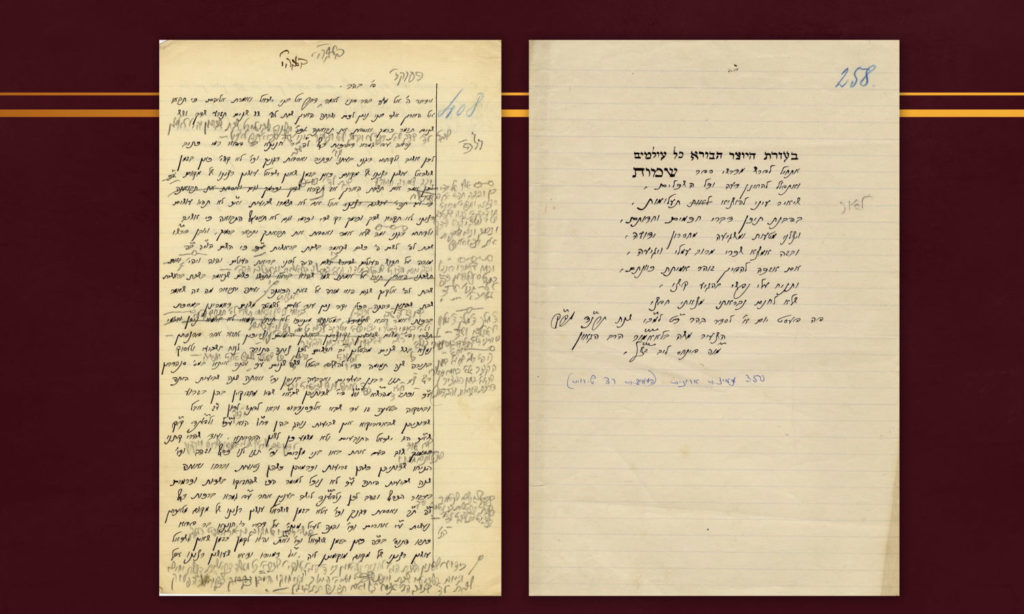
Large manuscript, over 300 leaves. Elucidations on the weekly Torah portions by Rabbi Moshe Friediger, head of the Budapest community for about 25 years.
Rabbi Moshe Friediger [1818-1897] was both scholarly and wealthy. He was a son of Rabbi Pinchas Leib Friediger, Ra’ava”d of Old Oiben. He was ordained to the rabbinate at the age of 18. After his wedding, his wealth and prominence greatly increased and he was among the first Jews – and the very first Chareidi Jew – to achieve a title of nobility, awarded by local royalty. He carried the burden of the people of Budapest and his net was cast across the entire country. [ Chachmai Hungariah 362-363].
After his passing, his sons printed his magnum opus, Moshe Yedaber , in two parts (Budapest 1927-1929) according to this manuscript.
[340] leaves written on one side of the leaf. Size: 21×33 cm. The first page is a title page for Sefer Shemot.
Fine condition. Light tears and creases in the margins of the leaves. Not bound.
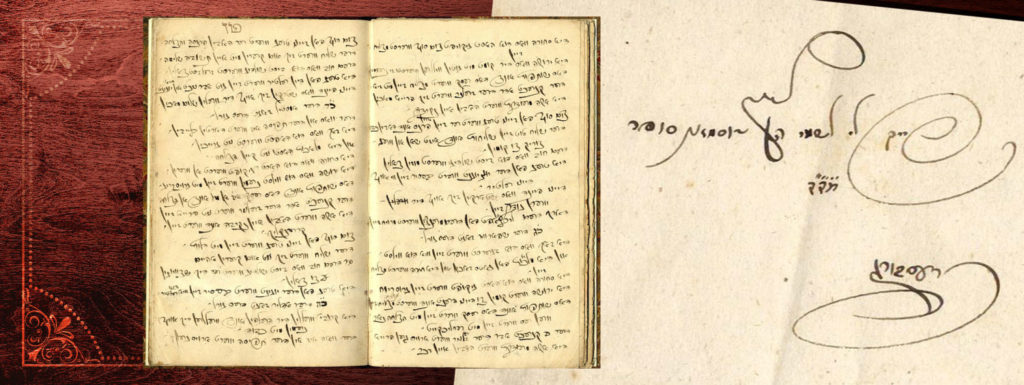
Bundle of manuscripts comprising an entire Sefer Goralot , and a transcription of part of the Chatam Sofer’s last will and testament and Torah novellae. Entirely handwritten and signed (three times) by the renowned gaon Rabbi Eliezer Zussman Sofer, av beit din of Paks, beloved disciple of the Chatam Sofer and son of the gaon Rabbi Ephraim Fischel Sofer, teacher of the Ktav Sofer, and the Chatam Sofer’s leading disciple in Kabbalah and amulet-writing! Pressburg, 1840s.
Manuscript contents: Rabbi Zussman Sofer’s signature appears on the first page of the manuscript, in his own handwriting: “Belongs to me … the youth Zussman Sofer, Pressburg” (additional signatures appear on pages 5a and 19b). On page 2a, there is a partial transcription of the Chatam Sofer’s will. On pages 2a through 19b – Sefer Goralot U’Mazalot . The last two pages of the manuscript bear Torah novellae on weekly Torah portions. All this, as stated, is in Rabbi Zussman Sofer’s hand.
This manuscript has never been published; it was passed down from generation to generation in the gaon Rabbi Eliezer Zussman Sofer’s family – the second-most prominent family dynasty in Hungary after the Chatam Sofer’s dynasty. This Sefer HaGoralot was written by Rabbi Zussman Sofer in his youth, when he was a young man only 14 years old, upon the Chatam Sofer’s passing, apparently as dictated by his father, Rabbi Ephraim Fischel, who served as writer of the Chatam Sofer’s amulets. He wanted to keep these secrets received from his teacher, the Chatam Sofer, in his family. As appears in the colophon at the end of Sefer HaGoralot : “So writes the youth Zussman Sofer, son of Mordechai Fischel Sofer, in Pressburg, Sunday 20 Iyar, 1842.” Despite Rabbi Eliezer Sofer’s authoring many books of halachah and aggadah over his lifetime, he never printed this; it remained in manuscript as a hidden scroll of secrets within the family.
To the extent of the Chatam Sofer’s prowess in the revealed Torah as rabbi of the entire Diaspora, so too was his prowess in the hidden Torah, received from his teacher, Rabbi Nathan Adler. However, he would hide this fact, even from his most prominent disciples. The Chatam Sofer did not deal with in-depth Kabbalah study only, he also practiced practical Kabbalah, as is known from the story about the first sermon given by his son Shimon Sofer, av beit din of Krakow, when he was appointed the city’s rabbi. Local scholars who were not pleased that a Hungarian gaon had been brought to serve in the most prestigious rabbinate of Poland – the city of the Ram”a – planned to shame him in the middle of his speech by making all sorts of strange requests. Rabbi Shimon, who caught on to their plot, opened his talk with a story about a violent butcher who refused to go to the Chatam Sofer’s beit din . His father sent him to warn the butcher that if he does not come to the beit din , the community will be forbidden to buy meat from him. Rabbi Shimon told his father about his concern – that he feared that this violent butcher would kill him. The Chatam Sofer taught him a sacred Name that had the power to kill the violent butcher. This name indeed came into use when – as he feared – the butcher did try to kill him in his rage. Rabbi Shimon whispered the Name, and the butcher fell down dead on the spot. Rabbi Shimon ended this story with a warning to his challengers by saying, “And I still remember that sacred Name!” Legend has it that for the entire length of this sermon, there was deadly fearful silence in the study hall, so still that the sound of a fly flying around in the synagogue could be heard.
The only disciple – aside from his sons – for whom the Chatam Sofer opened the doors of Kabbalah was Rabbi Ephraim Fischel Sofer, about whom the Chatam Sofer stated in one of his sacred writings to his father, Rabbi Zussman Sofer (the First): “To my dear friend, the sharp wondrous and expert tzaddik, his Torah honor, Rabbi Eliezer Zussman Sofer … Last week, a letter arrived from my teacher, the pious Kohen, Rabbi Nathan HaKohen … and I incidentally let him know about [your] son, my disciple … Ephraim, my beloved son, a delightful child who, whenever I speak of him, I remember him more and more for the good. From time to time, I study with him, and on Shabbat, he eats at my table … Mashha”k Sofer, Frankfurt am Main.” And as his son, Rabbi Eliezer Zussman (the Second, author of this manuscript) reliably attests: “Did you not know nor hear that the Chatam Sofer was a tremendous Kabbalist? Very rarely, he would give amulets, but only to his loved ones, those privy to his secret … The scribe for his amulets was always his close confidante and was also his disciple – this was my father, the gaon R’ Fischel Sofer” ( Sefer Zikaron L’Moshe , Grosswardein, 1938).
Books of lots have always been an important branch of practical Kabbalah, for the purpose of revealing the hidden and predicting the future. There are those who say that when the men of the Great Assembly saw that there were many who used them improperly, they hid these books from future generations, and only after the Greek decree on the Jewish people was lifted, did they reveal them to select individuals. Over the years, many handwritten Sefer HaGoralot manuscripts were transcribed, and even printed. This was also by leading Early Authorities, primarily Sephardim, the most well-known of them being the Ibn Ezra’s Sefer HaGoralot . But due to the fact that precision was required for the incantations and the times for conducting the lots, according to detailed instructions, together with the fact that the book’s copyists were not sufficiently expert, the lots did not result in the required results. Hence usage of practical Kabbalah waned.
As mentioned, over the years, many Sifrei Goralot were written and also printed, and they are even offered from time to time at auction. Nearly all of these Sifrei Goralot hail from Oriental countries, and all come from a single source and a single tradition. Yet, as stated, their usage ceased due to errors that crept into them, and consequently also their usefulness. Here, for the first time, is a Sefer Goralot from a different tradition in a different country – an Ashkenazic one. Not only that, it was written by one of the rabbinic leaders of Hungary, and son of the famous amulet writer and disciple of the rabbinic leader of the generation, the Chatam Sofer.
Refer to the Hebrew catalog text for a brief biography of the renowned gaon Rabbi Eliezer Zussman Sofer .
[46] pp of which [42] pp are written. 11×17 cm. Yiddish. This material has not been examined in the sufficient detail that befits its significance.
Fine condition: Aging stains. New semi-leather and marbleized paper binding.
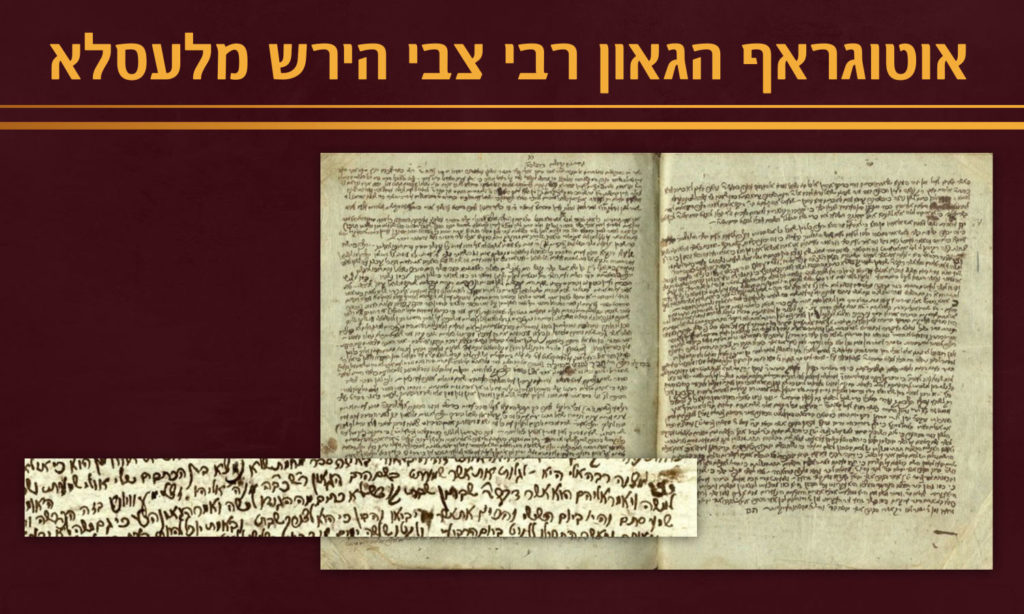
Delightful sermons with elucidations of scripture and words of mussar from the great sermonizer, Rabbi Tzvi, maggid meisharim of Loslau.
31 sermons. Each sermon bears a special name, for example, “Meil Katan, ” “Bigdei Yesha, ” “Shirat HaYam, ” “Lakachat Mussar, ” “Kessef Mezukak, ” etc.
Sermon 15, called “Kos Tamrurim, ” is a sermon about several rabbis and community leaders including the gaon Rabbi Azriel, Av Beit Din of Lublin [ Rosh HaBarzel ] and the minister, the great naggid Rabbi Yisrael b”r Tzvi of Warsaw, father-in-law of the gaon, Rabbi Shlomo Eiger.
In sermon 24, section 19: It is a big mitzvah for me to reveal that which I heard in the name of the gaon, the world-famous Rabbi Eliyahu ztz”l of Vilna.
In sermon 5 section 6: As an aside, I will reveal to you what I heard from the rabbi and gaon, the Av Beit Din of Lissa, author of Chavat Da’at .
In the middle of sermon 15, [17] leaves were bound with sermons for the high holidays, apparently by the above-mentioned author. Noted on the first sermon for Rosh HaShanah: 1820.
This manuscript is the book Klil Tiferet that was printed in Breslau in 1820 with an approbation from Rabbi Akiva Eiger, but the [17 leaves] mentioned above were not printed there.
The greatness and speaking prowess of Rabbi Tzvi, maggid meisharim of Loslau (b. 1772) are clearly recognizable to anyone who looks into his important and renowned book, Klil Tiferet . The beginning of the book bears approbations from Rabbi Akiva Eiger, the Chavat Da’at, and Rabbi Gedaliah Lipshitz, father of the ‘Tiferet Yisrael.’ Another work by him is called Tzvi Tiferet – on Shir HaShirim (Breslau, 1782).
[91] leaves, 18×22 cm. Dense script. Author’s autograph. Most of the paper is greenish.
Fine condition. Folds in the margins. Old, simple binding.